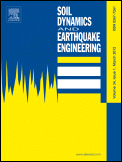
SOIL DYNAMICS AND EARTHQUAKE ENGINEERING
Scope & Guideline
Elevating Standards in Geotechnical and Structural Engineering Research
Introduction
Aims and Scopes
- Seismic Behavior of Soils and Structures:
Research on how various soil types behave under seismic loading, including soil-structure interaction effects, liquefaction phenomena, and dynamic response of foundations. - Innovative Seismic Isolation Techniques:
Development and evaluation of novel seismic isolation systems, such as base isolators and dampers, aimed at reducing seismic impacts on structures. - Experimental and Numerical Modeling:
Utilization of advanced experimental methods, including shaking table tests and centrifuge modeling, alongside sophisticated numerical simulations to predict and analyze seismic responses. - Risk Assessment and Mitigation Strategies:
Focus on probabilistic seismic hazard assessment, vulnerability analysis, and the development of strategies to mitigate earthquake-induced damages. - Material Behavior Under Dynamic Loads:
Investigation of the properties and performance of construction materials, including soil-cement mixtures and recycled materials, under seismic conditions.
Trending and Emerging
- Machine Learning and AI in Seismic Analysis:
The integration of machine learning and artificial intelligence techniques for predicting seismic responses and assessing vulnerability is gaining traction, indicating a shift towards data-driven approaches. - Sustainability in Geotechnical Engineering:
Research focusing on sustainable materials and practices in geotechnical engineering, including the use of recycled materials and eco-friendly construction techniques, is on the rise. - Advanced Seismic Isolation Systems:
There is a growing interest in the development and optimization of innovative seismic isolation systems that incorporate new materials and technologies to enhance building resilience. - Real-Time Monitoring and Assessment:
Emerging themes include the real-time assessment of structural health and seismic response using advanced monitoring technologies and data analytics. - Impact of Climate Change on Seismic Resilience:
Research exploring the intersections of climate change, soil behavior, and seismic resilience is becoming increasingly significant, addressing how changing environmental conditions affect earthquake preparedness.
Declining or Waning
- Traditional Analytical Methods for Seismic Analysis:
There has been a noticeable decline in the publication of papers utilizing conventional analytical methods for seismic analysis, as researchers increasingly favor advanced computational techniques and machine learning approaches. - Static Analysis Techniques:
Static analysis methods are becoming less prevalent in favor of dynamic analysis approaches that better capture the complexities of soil-structure interactions during seismic events. - Focus on Historical Earthquake Studies:
Research centered on historical earthquake data and case studies is diminishing as the field shifts towards predictive modeling and real-time response analysis. - Simplistic Models for Soil Behavior:
Older, less sophisticated models for predicting soil behavior under seismic loads are being phased out in favor of more complex, realistic models that account for nonlinearity and spatial variability.
Similar Journals

Earthquake Science
Innovating Understanding of Earth’s ShakingEarthquake Science is a prominent open access journal that has been serving the scientific community since its inception in 2009, published by KEAI PUBLISHING LTD. With an ISSN of 1674-4519 and an E-ISSN of 1867-8777, this journal has established itself as a significant platform for the dissemination of research in the fields of geology, geophysics, and geotechnical engineering, evident from its Q2 ranking in 2023 across these categories. Based in China, Earthquake Science aims to facilitate knowledge sharing and foster interdisciplinary collaboration by publishing a range of high-quality articles, reviews, and research papers demonstrating advancements in understanding seismic activity and its impacts. Its commitment to open access since 2015 ensures that valuable insights are available to researchers, professionals, and students globally, thereby supporting critical inquiries into earthquake mechanisms and risk management strategies. Explore the latest findings and contribute to the ongoing conversation in the evolving landscape of earthquake science.

International Journal of GEOMATE
Pioneering research that transforms challenges into solutions.The International Journal of GEOMATE, published by GEOMATE INT SOC based in Japan, is a pivotal resource for scholars and practitioners in the fields of Building and Construction, Environmental Engineering, Geotechnical Engineering, and Soil Science. Established in 2011 and continuing to set the standard in its focus areas, this journal serves as a platform for innovative research and practical applications, with contributions that significantly enhance the understanding and development of sustainable engineering practices. With its current classification in the Q3 quartile across multiple categories, it strives to disseminate critical knowledge and foster dialogue among a diverse audience, including researchers, industry professionals, and students. Though operating under a traditional subscription model, the journal's emphasis on rigorous peer review and high-quality publications ensures a substantial impact factor, further reinforcing its reputation in academia. Spanning from 2011 to 2024, the International Journal of GEOMATE invites contributions that advance the knowledge frontier and address contemporary challenges in engineering and environmental science.

Ingegneria Sismica
Connecting researchers to enhance earthquake engineering insights.Ingegneria Sismica, a premier journal published by PATRON EDITORE S R L, serves as an essential platform for the dissemination of research in the fields of building and construction, geotechnical engineering, and safety risk management. With a focus on earthquake engineering and structural safety, the journal has established itself as a prominent source of knowledge since its inception in 2010. The journal holds an impressive Q2 classification in multiple categories, including Building and Construction and Geotechnical Engineering, reflecting its significant impact within these disciplines. Despite its Italian roots, it appeals to an international audience of researchers, professionals, and students dedicated to advancing the understanding of seismic resilience and risk mitigation strategies. Although open access is not currently available, the potential for knowledge sharing and innovative methodologies presented in the articles continues to attract a robust readership. With its commitment to excellence and relevance, Ingegneria Sismica is poised to shape future discourse in engineering practices aimed at enhancing safety, reliability, and quality within seismic zones.
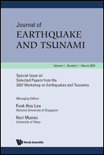
Journal of Earthquake and Tsunami
Navigating the complexities of seismic activity and ocean waves.Welcome to the Journal of Earthquake and Tsunami, a premier scholarly publication dedicated to advancing the field of geophysical research, with a particular focus on seismic activity and tsunami phenomena. Published by World Scientific Publishing Co Pte Ltd, this journal provides a vibrant platform for researchers and practitioners alike to share their findings and innovations, contributing to the global understanding of these critical natural events. With an impact factor that reflects its relevance, the journal is categorized in Q3 quartiles for 2023 in areas including Geophysics, Geotechnical Engineering, and Oceanography, indicating a solid standing in the scientific community. It is indexed within Scopus, ranking in the upper half of its categories, which further establishes its importance as a resource for students and professionals seeking to stay informed about the latest developments. Although the journal operates under a traditional access model, its commitment to fostering scholarly discourse remains unwavering. Founded in 2008 and set to converge its offerings until 2024, the Journal of Earthquake and Tsunami continues to be an invaluable resource for anyone dedicated to understanding the dynamic and often dangerous interactions of our planet’s geological features.
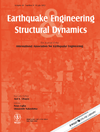
EARTHQUAKE ENGINEERING & STRUCTURAL DYNAMICS
Driving excellence in earthquake engineering and dynamics.EARTHQUAKE ENGINEERING & STRUCTURAL DYNAMICS, published by Wiley, is a leading journal recognized for its significant contributions to the domains of civil and structural engineering, as well as geotechnical engineering and engineering geology. With an impressive Q1 ranking in multiple categories, including Civil and Structural Engineering, and an esteemed Scopus ranking placing it in the 82nd percentile, the journal serves as a premier platform for disseminating pioneering research and innovative methodologies related to earthquake engineering and dynamic structural analysis. Established in 1972, this journal boasts a comprehensive coverage of topics from theoretical developments to practical applications, making it an essential resource for researchers, industry professionals, and students eager to expand their understanding of seismic safety and structural resilience. Though it does not offer open access, the journal continues to be a cornerstone for scholarly communication within the earthquake engineering community, advancing knowledge that shapes better engineering practices worldwide.
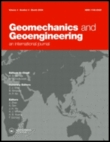
Geomechanics and Geoengineering-An International Journal
Advancing the Frontiers of Geotechnical InnovationGeomechanics and Geoengineering-An International Journal, published by Taylor & Francis Ltd, serves as a prominent platform for the dissemination of innovative research and advancements in the fields of Geotechnical Engineering and Engineering Geology. With an ISSN of 1748-6025 and E-ISSN of 1748-6033, this journal has established itself as a critical resource within its category, ranking in the Q2 quartile according to the 2023 metrics and positioning itself in the top 38% of the Scopus rankings for Earth and Planetary Sciences. Geomechanics and Geoengineering encompasses a diverse range of topics, including but not limited to soil mechanics, foundation engineering, rock mechanics, and environmental geotechnics, ultimately aiming to advance both theoretical and practical knowledge in these vital areas. This journal not only highlights pioneering research but also facilitates a platform for academia and industry practitioners to collaborate and exchange ideas. While it does not offer open access, it remains a valuable resource for institutions and individuals committed to enhancing their expertise in the geotechnical domain. With convergence years spanning from 2006 to 2024, this journal is equipped to significantly contribute to the evolving landscape of geomechanical research.
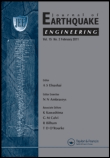
JOURNAL OF EARTHQUAKE ENGINEERING
Exploring the forefront of earthquake engineering.JOURNAL OF EARTHQUAKE ENGINEERING, published by TAYLOR & FRANCIS LTD, stands as a pivotal resource in the fields of Building and Construction, Civil and Structural Engineering, and Geotechnical Engineering. With an impressive Q1 ranking in multiple categories for 2023, this journal is instrumental for researchers, professionals, and students committed to advancing knowledge in earthquake engineering and its practical applications. As a platform that spans the years from 1997 to 2024, it highlights significant contributions to safety, risk, reliability, and quality in engineering practices. While the journal operates on a subscription basis, its highly regarded articles, bolstered by robust Scopus rankings—such as rank #46 in Building and Construction—underscore its credibility and influence in shaping standards and methodologies within the discipline. Promoting innovative and evidence-based approaches, the JOURNAL OF EARTHQUAKE ENGINEERING is essential reading for anyone engaged in the science and technology of earthquake-resistant structures.
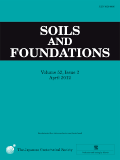
Soils and Foundations
Elevating civil engineering through innovative soil research.Soils and Foundations, an esteemed journal published by the Japanese Geotechnical Society, has established itself as a pivotal platform for innovative research in Civil and Structural Engineering and Geotechnical Engineering. With an impressive impact factor reflected in its Q1 quartile ratings for both disciplines, the journal provides critical insights that foster advancements in the understanding of soil behavior and foundation design. Since its transition to Open Access in 2020, Soils and Foundations has broadened its reach, ensuring accessible dissemination of knowledge to researchers, students, and professionals globally. With a rich history dating back to its inception in 1960, the journal continues to uphold a high standard of scholarly excellence, ranking within the top percentile in Scopus across geotechnical engineering fields. This commitment to quality and accessibility makes it an essential resource for anyone engaged in the vital areas of soil mechanics and foundation engineering.

Transportation Infrastructure Geotechnology
Innovating Geotechnical Solutions for Sustainable Transport.Transportation Infrastructure Geotechnology, an esteemed journal published by SpringerNature, serves as a vital platform in the fields of Civil and Structural Engineering, Environmental Engineering, Geotechnical Engineering, and Transportation. Established in 2014 and spanning a decade of significant scientific discourse, this journal has gained recognition for its robust contribution to the understanding of the interplay between geotechnical processes and transportation infrastructure. With an impactful Q2 ranking in multiple categories—including Civil and Structural Engineering and Environmental Engineering—it emphasizes innovative research and practical applications globally. Researchers and professionals can explore critical topics that influence infrastructure sustainability, safety, and efficiency. Although it operates under a subscription model, its affiliation with SpringerNature ensures rigorous peer-review and high-quality publications, making it an indispensable resource for academics and industry experts alike.

Bulletin of the New Zealand Society for Earthquake Engineering
Exploring the forefront of earthquake engineering advancements.Bulletin of the New Zealand Society for Earthquake Engineering (ISSN: 1174-9857, E-ISSN: 2324-1543) is a leading scholarly journal published by the New Zealand Society for Earthquake Engineering, Inc., dedicated to advancing the field of earthquake engineering. Since its inception in 1970, the journal has provided a vital platform for the dissemination of innovative research, technical studies, and case reports related to civil and structural engineering, as well as geotechnical engineering and engineering geology. Recognized for its significant contributions, the journal holds a Q2 ranking in both the Civil and Structural Engineering and Geotechnical Engineering and Engineering Geology categories as of 2023. It serves as an invaluable resource for researchers, professionals, and students keen on enhancing their understanding of earthquake resilience and engineering practices. While the journal operates under subscription-based access, its rigorous peer-review process ensures that published articles meet the highest academic standards, making it a credible source for the global engineering community.